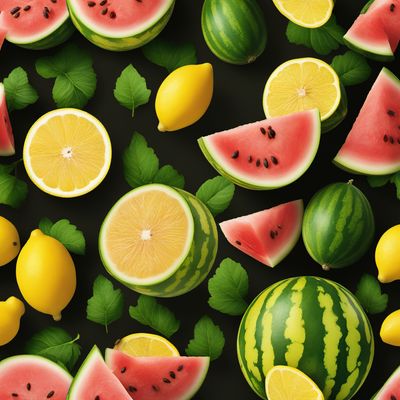
Ingredient
Watermelons and similar-
The Refreshing Oasis: Exploring the Juicy World of Watermelons and Similar Fruits
Watermelons and similar fruits are large, round fruits with a thick rind and a juicy, sweet flesh. They are known for their high water content, which makes them incredibly hydrating and refreshing. The flesh of these fruits is typically red or pink, although there are also varieties with yellow or orange flesh. The texture is crisp and juicy, with a slight crunch from the seeds or a seedless variety.
Origins and history
Watermelons have a long history that can be traced back to ancient Egypt, where they were cultivated along the Nile River. They were highly prized for their ability to provide hydration in the hot desert climate. Watermelons eventually spread to other parts of the world, becoming a beloved fruit in many cultures. Today, they are a staple of summer picnics, barbecues, and beach outings.
Nutritional information
Watermelons and similar fruits are low in calories and fat, making them a guilt-free treat. They are also a good source of vitamins A and C, as well as other antioxidants that promote overall health and well-being. Additionally, watermelons are hydrating due to their high water content, making them an excellent choice for staying hydrated during hot weather or physical activity.
How to select
When selecting a watermelon or similar fruit, look for a fruit that feels heavy for its size. This indicates that it is juicy and ripe. The rind should be firm and free from any soft spots or bruises. The underside of the fruit should have a creamy yellow color, indicating that it is fully ripe. Avoid fruits with a pale or greenish underside, as they may be underripe.
Storage recommendations
To store a watermelon or similar fruit, keep it at room temperature for a few days to allow it to fully ripen. Once ripe, it can be stored in the refrigerator for up to a week. Cut watermelon should be stored in an airtight container in the refrigerator and consumed within a few days. It is best to consume watermelon when it is chilled, as it enhances the refreshing taste and texture.
How to produce
Watermelons and similar fruits can be grown in home gardens or purchased from grocery stores or farmers markets. They require a sunny location and well-drained soil. The fruits should be harvested when they have reached their full size and have a dull rind. To check for ripeness, tap the fruit and listen for a deep, hollow sound.
Preparation tips
To prepare a watermelon or similar fruit, start by cutting it into slices or cubes. The rind can be removed or left intact, depending on personal preference. Watermelon can be enjoyed on its own as a refreshing snack, or it can be used in a variety of recipes, such as salads, smoothies, or sorbets. The seeds can be removed or consumed, depending on the variety of watermelon.
Culinary uses
Watermelons and similar fruits are commonly enjoyed as a refreshing snack on their own. They are also a popular addition to fruit salads, where their juicy sweetness adds a burst of flavor. Watermelon can be used to make refreshing beverages, such as agua frescas or cocktails. In addition, the flesh of watermelons can be grilled or roasted to enhance its natural sweetness and create a unique flavor profile. Watermelons are widely used in cuisines around the world and are available in various forms, such as fresh, frozen, or canned.
Availability
Commonly available in many regions around the world, especially during the summer months.
